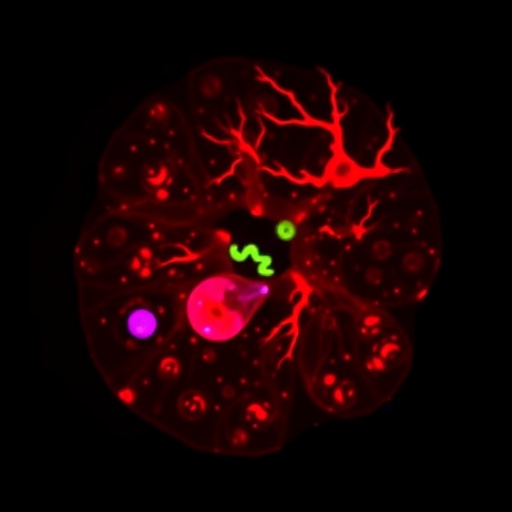In a groundbreaking advancement for melanoma treatment, researchers from nine leading U.S. cancer centers have completed a pivotal multicenter clinical trial demonstrating the capability of a gene expression profile–based test to predict the risk of melanoma metastasis to sentinel lymph nodes. This test, integrating molecular profiling with clinicopathologic data, offers a sophisticated means to personalize melanoma care, potentially diminishing the need for invasive sentinel lymph node biopsies (SLNB) in many early-stage patients. Published in the esteemed journal JAMA Surgery, the MERLIN_001 trial heralds a new era in stratifying melanoma patients based on precision diagnostics rather than solely traditional histological and clinical factors.
Melanoma, a malignancy of pigment-producing melanocytes, is notorious for its potential to metastasize early through lymphatic pathways. The identification of nodal metastatic involvement remains a cornerstone in staging and guiding therapeutic decisions. Currently, sentinel lymph node biopsy—a procedure in which the first draining lymph node(s) from a tumor site is surgically removed and analyzed—serves as the gold standard for evaluating nodal status. However, this procedure, although minimally invasive compared to full lymphadenectomy, still carries risks such as surgical complications, lymphedema, and anesthesia-related effects, highlighting the clinical imperative to refine patient selection for SLNB.
The MERLIN_001 trial, spearheaded by Dr. Vernon Sondak of Moffitt Cancer Center, leveraged a clinicopathologic gene expression profile test that uniquely synthesizes molecular gene expression patterns with key clinical data, including age and tumor thickness. This nuanced profile enhances risk stratification by categorizing patients into low- or high-risk groups for sentinel lymph node metastasis with superior accuracy compared to traditional clinical parameters alone. By assessing expression signatures alongside tumor mitotic rate and histologic subtype, this test offers a multifaceted biomarker platform that captures the tumor’s molecular aggressiveness and clinical behavior.
Crucially, the blinded, prospective nature of the study—which analyzed data from over 1,700 early-stage melanoma patients—affirms the robustness and reproducibility of the test. Participants with T1b to T3b melanomas and select high-risk T1a lesions were enrolled between 2021 and 2024. All patients underwent standard sentinel lymph node biopsy independent of gene expression results, ensuring unbiased assessment of the assay’s predictive power. Importantly, neither patients nor clinicians had access to test outcomes at the time of treatment, preserving the trial’s integrity in evaluating true predictive accuracy.
The trial’s results reveal that the gene expression profile test classified 37% of participants as low risk for nodal metastasis, with an impressively low sentinel node positivity rate of only 7.1% within this group. In stark contrast, the high-risk group exhibited a substantially elevated positivity rate of 23.8%. The negative predictive value—a measure indicating the probability that patients classified as low risk truly do not have nodal involvement—reached 92.9%, underscoring the test’s reliability in ruling out occult nodal disease. Such a high negative predictive value suggests that a significant subset of patients might safely omit SLNB without compromising oncologic outcomes.
An additional salient finding is the assay’s consistent performance across diverse melanoma subtypes, anatomical tumor sites, and age brackets, including patients aged 65 and older. Notably, nearly half of elderly patients were classified as low risk, with only a 6.6% sentinel node positivity rate, indicating that the test could have particular utility in populations where surgical morbidity is often a greater concern. This stratification capability augments personalized medicine efforts, guiding nuanced surgical decisions that balance disease control with quality of life considerations.
From a clinical management perspective, sentinel lymph node status heavily influences subsequent treatment algorithms, including indications for adjuvant immunotherapy and tailored surveillance protocols. By reliably identifying patients at low risk for nodal involvement, the gene expression profile test stands to reduce the frequency of unnecessary SLNB procedures that contribute to healthcare costs, patient anxiety, and procedural complications. This aligns with a broader movement towards de-escalation of overtreatment in oncology when safe and feasible.
Dr. Jonathan Zager, a surgical oncologist contributing to the study, highlighted the trial’s transformative potential: integrating molecular diagnostics with clinical judgement equips physicians with an evidence-based tool to optimize care pathways. The Merlin assay’s ability to discern truly low-risk individuals enables clinicians to contemplate foregoing SLNB—and thus general anesthesia—for many patients, an advancement with considerable implications for patient safety and resource utilization.
This study builds upon prior smaller retrospective and prospective analyses, which suggested that gene expression profiling could supplement risk assessment in melanoma. The MERLIN_001 trial’s large sample size and prospective design provide the highest level of evidence to date supporting the clinical application of molecular classifiers in determining sentinel node status. These findings may invigorate guideline discussions and reshape recommendations surrounding SLNB candidacy.
The gene expression profile test combines the analysis of expression levels of multiple genes implicated in melanoma progression and metastatic potential, integrating this molecular signature with established clinical factors via sophisticated algorithms. This holistic approach capitalizes on the pathobiological heterogeneity of melanoma, surpassing the predictive limitations of conventional staging metrics. Incorporating such precision tools represents a paradigm shift from population-based guidelines to individual-centric decision-making.
As this assay gains traction and adoption in clinical practice, ongoing research will be critical to monitoring long-term outcomes, validating the reproducibility of findings across broader populations, and evaluating cost-effectiveness. Meanwhile, the promise of refining the melanoma treatment landscape through minimally invasive, molecularly guided strategies offers hope for improved patient experiences and outcomes.
Moffitt Cancer Center, a nationally recognized Comprehensive Cancer Center, serves as a hub for innovative oncology research and multidisciplinary care delivery. The MERLIN_001 trial exemplifies collaborative efforts leveraging cutting-edge molecular science to translate research breakthroughs into tangible clinical benefits, advancing toward Moffitt’s mission to prevent and cure cancer.
This landmark trial signifies a momentous step in melanoma research, demonstrating how the confluence of genomics and clinical oncology can transform surgical decision-making. With the capacity to accurately predict nodal metastasis risk, the gene expression profile test stands poised to redefine standards of care, optimize therapeutic strategies, and ultimately improve the lives of countless melanoma patients worldwide.
Subject of Research: People
Article Title: Gene Expression Profile–Based Test to Predict Melanoma Sentinel Node Status
News Publication Date: 22-Oct-2025
Web References:
JAMA Surgery Article
Moffitt Cancer Center
National Cancer Institute-designated Comprehensive Cancer Centers
References:
10.1001/jamasurg.2025.4399
Keywords: Cancer research
Tags: advancements in melanoma researchearly-stage melanoma managementgene expression profiling for melanomaJAMA Surgery publicationlymph node metastasis risk assessmentmelanoma metastasis predictionMERLIN_001 clinical trial resultsmolecular profiling in cancer carenon-invasive melanoma diagnosticspersonalized melanoma treatmentprecision medicine in oncologysentinel lymph node biopsy alternatives





